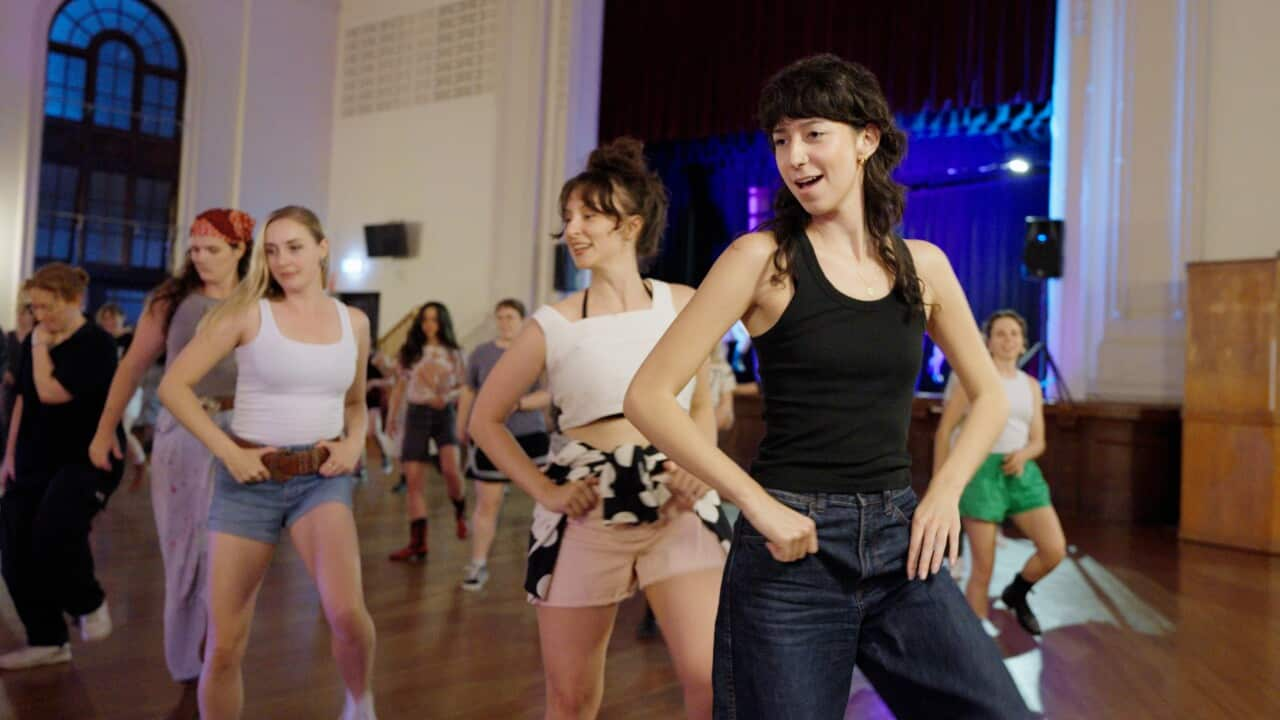“Hello everyone and welcome to Saddle Club. Saddle Club is all about, as much as you can, getting out of your head and into your body; feeling silly, feeling sexy,” Marzy says, addressing a roomful of excitable queers.

Saddle Club is for everyone but is queer-led and queer-focused. Source: SBS News / Jack Tulleners
She pays respect to queer elders, who have been dancing together for decades, and acknowledges that Saddle Club was inspired by a US-based linedancing event called Stud Country.
Marzy, flanked by Saddle Club backup dancers, demonstrates the steps and the audience follows. It’s 45 minutes of stomps, turns and sweat.
“[Saddle Club] is something that’s quite wholesome and activity-driven. And I think it’s certainly made us reflect that maybe people are craving that: a space where they can come and have some fun and be very silly, but also get to meet people and socialise in a way that is different to maybe going out on the weekend.”
More than linedancing
But it immediately grew to a much-loved weekly event, selling hundreds of tickets.

Marzy, Saddle Club’s co-founder, says she grew up linedancing with her mother and grandmother. Source: SBS News / Jack Tulleners
For Marzy, there’s a personal connection — she grew up linedancing with her mum and grandma.
“My mum has always danced. She was also an incredible rock’n’roll dancer, but my mum got my nan into linedancing as a way of keeping fit and healthy and moving her body in a way that was pretty gentle.”
“I’ve got this very precious photo of me, my mum, and my nan together in a vest that my mum still has — linedancing. So yeah, it was a cute activity to do together.”

A young Marzy linedancing with her mum and grandma. Source: Supplied
She says they come up with the choreography by watching “YouTube videos that have 300 views” and adapting the dances to pop songs.
Queer bootscooting
“I think having queer-led spaces are really important, where the community can feel seen and feel like it’s a space truly for them.”

The connection between queerness, linedancing and country music is longstanding, says Marzy. Source: SBS News / Jack Tulleners
Groups of queers started linedancing in Australia in the mid-80s, when AIDS was starting to spread around the world.
John Bishop was an early adopter of queer linedancing in Melbourne, becoming a volunteer instructor with the New Frontier Dancing Association, which started around 1989.

An article on bootscooting featured in Campaign Australia magazine, in 1988. Source: Supplied / National Library of Australia
For the last 31 years, he’s been teaching linedancing through his business Cowboy Culture.
“It’s a great social activity. It’s not a ‘meat market’ kind of activity like going to a club would be, it’s good fun. It allows people to express themselves.”
“The media pounced on it. We had so many magazines and journalists wanting to come to our events and they filmed boots — they were obsessed with boots.”

Groups of queers started linedancing in Australia in the mid-80s. Source: SBS News / Jack Tulleners
But he said eventually mass interest fizzled out among the queer community.
He says there were different varieties of linedancing, including ‘clogging’ — a style of dance that involves stomping and striking the floor with one’s heel — and a form of partner dancing called ‘two-stepping’.
Men danced with men and women danced with women; women danced with men.
She says they have “exciting plans” for 2025, so “watch this space”.
